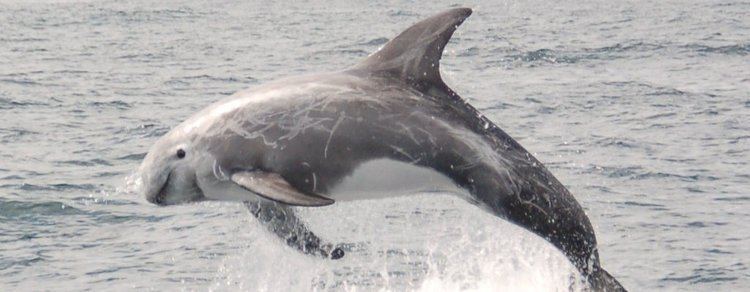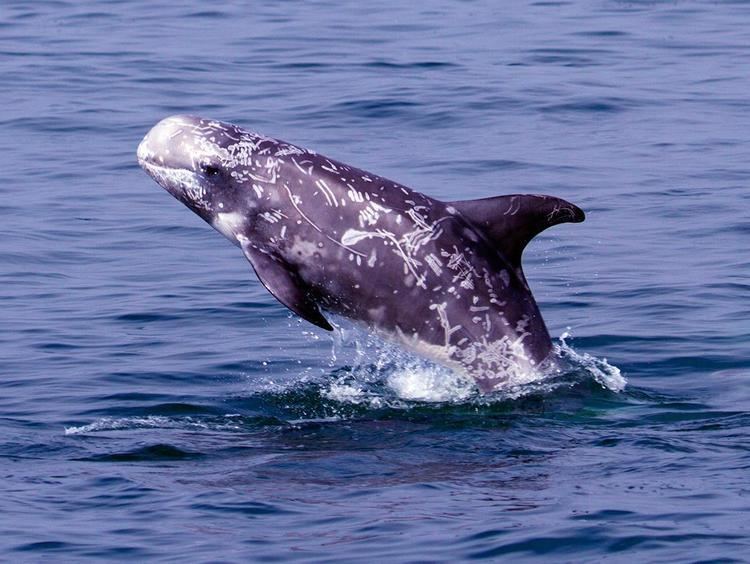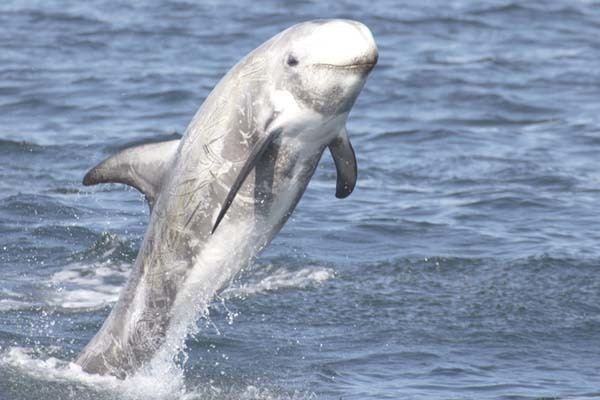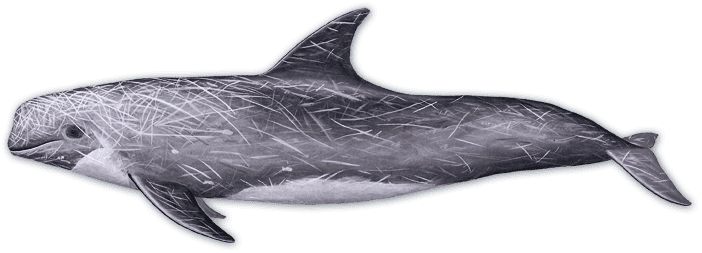Order Artiodactyla Family Delphinidae Scientific name Grampus griseus Rank Species | Phylum Chordata Genus GrampusGray, 1828 Higher classification Grampus | |
 | ||
Similar Stenella, Striped dolphin, Common dolphin, Short‑beaked common dolphin, False killer whale | ||
Risso s dolphins
Risso's dolphin (Grampus griseus) is the only species of dolphin in the genus Grampus. It is commonly known as the Monk dolphin among Taiwanese fishermen.
Contents
- Risso s dolphins
- Risso s dolphins bardsey island wales
- Taxonomy
- Description
- Range and habitat
- Ecology
- Reproduction
- Conservation
- Strandings
- References

Risso s dolphins bardsey island wales
Taxonomy

Risso's dolphin is named after Antoine Risso, whose description formed the basis of the first public description of the animal, by Georges Cuvier, in 1812. Another common name for the Risso's dolphin is grampus (also the species' genus), although this common name was more often used for the orca. The etymology of the word "grampus" is unclear. It may be an agglomeration of the Latin grandis piscis or French grand poisson, both meaning big fish. The specific epithet griseus refers to the mottled (almost scarred) grey colour of its body.
Description
Risso's dolphin has a relatively large anterior body and dorsal fin, while the posterior tapers to a relatively narrow tail. The bulbous head has a vertical crease in front.

Infants are dorsally grey to brown and ventrally cream-colored, with a white anchor-shaped area between the pectorals and around the mouth. In older calves, the nonwhite areas darken to nearly black, and then lighten (except for the always dark dorsal fin). Linear scars mostly from social interaction eventually cover the bulk of the body. Older individuals appear mostly white. Most individuals have two to seven pairs of teeth, all in the lower jaw.

Length is typically 10 feet (3.0 m), although specimens may reach 13.12 feet (4.00 m). Like most dolphins, males are typically slightly larger than females. This species weighs 300–500 kilograms (660–1,100 lb), making it the largest species called "dolphin".
Range and habitat
They are found worldwide in temperate and tropical waters, usually in deep waters rather, but close to land. As well as the tropical parts of the Indian, Pacific and Atlantic Oceans, they are also found in the Persian Gulf and Mediterranean and Red Seas, but not the Black Sea (a stranding was recorded in the Sea of Marmara in 2012). They range as far north as the Gulf of Alaska and southern Greenland and as far south as Tierra del Fuego.
Their preferred environment is just off the continental shelf on steep banks, with water depths varying from 400–1,000 m (1,300–3,300 ft) and water temperatures at least 10 °C (50 °F) and preferably 15–20 °C (59–68 °F).
The population around the continental shelf of the United States is estimated to be in excess of 60,000. In the Pacific, a census recorded 175,000 individuals in eastern tropical waters and 85,000 in the west. No global estimate exists.
Ecology
They feed almost exclusively on neritic and oceanic squid, mostly nocturnally. Predation does not appear significant. Mass strandings are infrequent. Analysis carried out on the stomach contents of stranded specimens in Scotland showed that the most important species preyed on in Scottish waters is the curled octopus.
These dolphins typically travel in groups of 10–51, but that may reach 400. Smaller, stable subgroups exist within larger groups. They also travel with other cetaceans. They harass and surf the bow waves of gray whales, as well as ocean swells.
Reproduction
Gestation requires an estimated 13–14 months, at intervals of 2.4 years. Calving reaches seasonal peaks in the winter in the eastern Pacific and in the summer and fall in the western Pacific. Females mature sexually at ages 8–10, and males at age 10–12. The oldest specimen reached 39.6 years.
Risso's dolphins have successfully been taken into captivity in Japan and the United States, although not with the regularity of bottlenose dolphins or orcas. Hybrid Risso's-bottlenose dolphins have been bred in captivity.
Under the name "grampus", it was one of the royal fish which were traditionally the property of the English Crown.
Conservation
The Risso's dolphin populations of the North, Baltic, and Mediterranean Seas are listed on Appendix II of the Convention on the Conservation of Migratory Species of Wild Animals (CMS), since they have an unfavourable conservation status or would benefit significantly from international co-operation organised by tailored agreements.
In addition, Risso's dolphin is covered by the Agreement on the Conservation of Small Cetaceans of the Baltic, North East Atlantic, Irish and North Seas (ASCOBANS), the Agreement on the Conservation of Cetaceans in the Black Sea, Mediterranean Sea and Contiguous Atlantic Area (ACCOBAMS), the Memorandum of Understanding for the Conservation of Cetaceans and Their Habitats in the Pacific Islands Region (Pacific Cetaceans MoU) and the Memorandum of Understanding Concerning the Conservation of the Manatee and Small Cetaceans of Western Africa and Macaronesia (Western African Aquatic Mammals MoU).
Risso's dolphins are protected in the United States under the Marine Mammal Protection Act of 1992. The only country known to actively hunt Risso's dolphin is Japan.
Strandings
At least one case report of strandings in Japan's Goto Islands has been associated with parasitic neuropathy of the eighth cranial nerve by a trematode in the genus Nasitrema.
